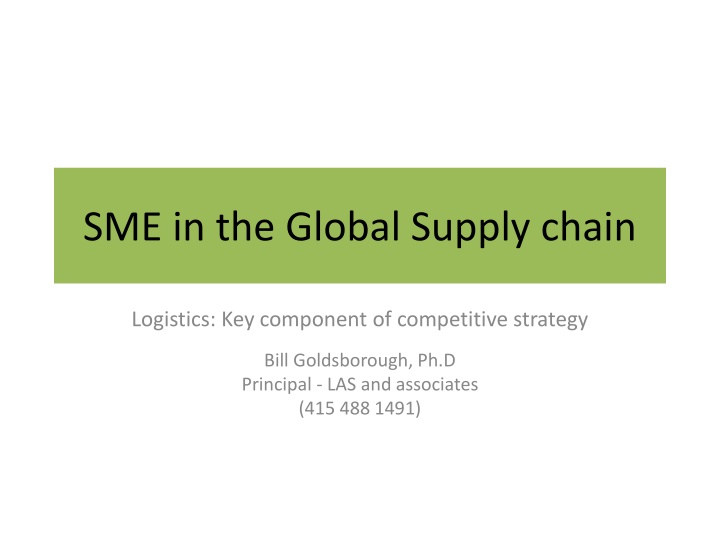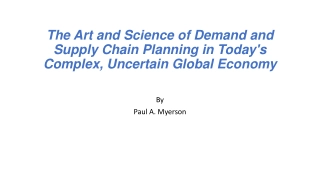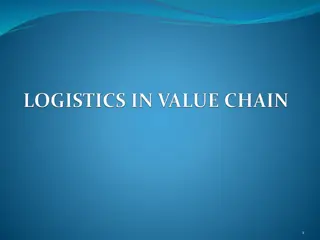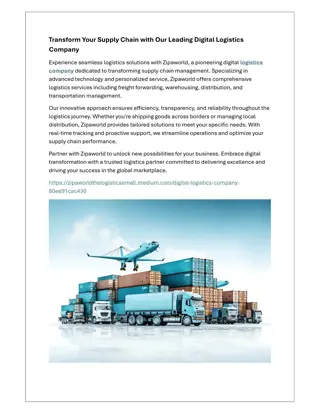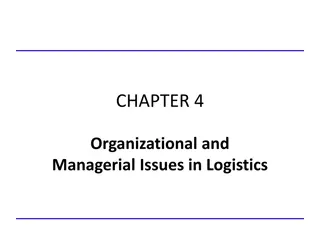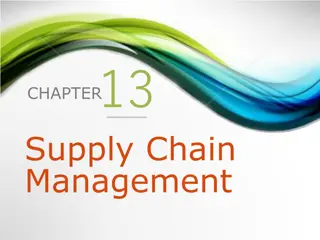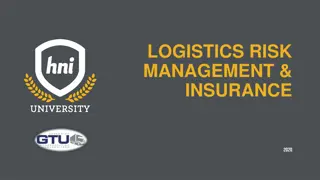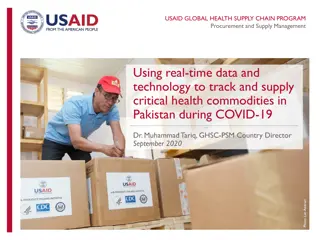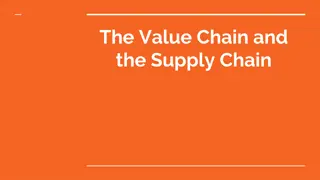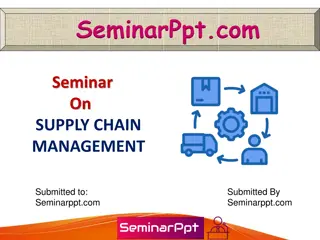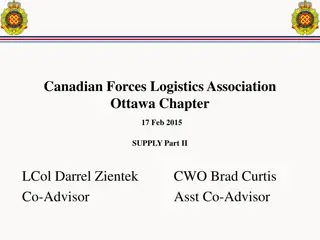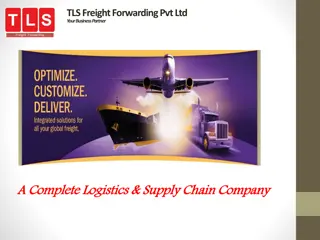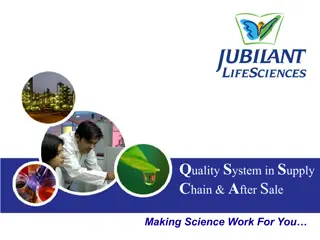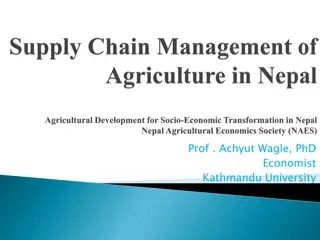SME in Global Supply Chain Logistics: Competitive Strategy Overview
Today's business landscape emphasizes the significance of supply chain and logistics in global operations. Dr. Bill Goldsborough explores key components of competitive strategy for SMEs, delving into globalization drivers, smooth supply chain functioning, essential processes, process improvement impacts, and software enablers. Discover why upgrading global logistics capabilities is crucial for SME success.
Download Presentation

Please find below an Image/Link to download the presentation.
The content on the website is provided AS IS for your information and personal use only. It may not be sold, licensed, or shared on other websites without obtaining consent from the author.If you encounter any issues during the download, it is possible that the publisher has removed the file from their server.
You are allowed to download the files provided on this website for personal or commercial use, subject to the condition that they are used lawfully. All files are the property of their respective owners.
The content on the website is provided AS IS for your information and personal use only. It may not be sold, licensed, or shared on other websites without obtaining consent from the author.
E N D
Presentation Transcript
SME in the Global Supply chain Logistics: Key component of competitive strategy Bill Goldsborough, Ph.D Principal - LAS and associates (415 488 1491)
Todays agenda Brief review of business globalization Importance of supply chain in global arena Logistics as a key component of supply chain Processes involved in global logistics One SME s approach to global logistics Why today is a good time for the SME to begin to upgrade its global logistics capability Next steps for SMEs 2
Drivers of business globalization Market forces Sell in international markets Source from multiple markets Invest in multiple markets, e.g. ops, R&D Policy and technology forces Trade and capital liberalization Transport, communications & information technology Market privatization 3
A smooth functioning supply chain is a key condition for success Get the right product, in the right quantities, in the right condition to the right place at the right time and at the right price To do this need to break down barriers between traditional business functions, e.g. manufacturing, marketing, etc. Focus instead on key customer related processes like order cycle, complete orders, on-time deliveries 4
Broadly there are 4 key processes a company must perform Make Fulfill Plan Source 5
Process improvement has had a significant impact on the bottom line IBM reduced overall costs by $12 billion between 02 & 05, according to AMR Increasing evidence of positive correlation between process improvement and key financial indicators, e.g. share price, materials cost, cash to cash cycle times 6
Software has been a key enabler of process improvement and has led to closer cooperation between firms Enterprise resource planning (ERP), Supply chain planning (SCP), Transportation planning (TM), Customer relationship Planning (CRM), etc Global trade management (GTM) software Web-based portals 7
Globalization and supply chain technologies have led to a new phenomenon: Global production networks U.S. Asia (1) . Toshiba (2) BestBuy Contract firms (3) TSMC D&H (4) Zoran (5) (6) Applied Materials 8
Logistics (fulfillment) is a key process of the integrated global supply chain But, more limited in scope than the supply chain Nonetheless it has huge cost and customer service implications This combination presents opportunity to improve financial, operational and service performance relatively quickly 9
Global logistics is comprised of four key activities that need to be carefully managed today Inventory management Transport spend management Import/export process management Logistics outsource management 10
Careful inventory management is more important than ever because of the far flung nature of the global supply chain Holding inventory is costly Current recession could have long-term impact on channel management Examples of tools for managing inventory VMI Cross docking Merge in-transit Postponement Optimization Visibility software 11
Visibility software is foundation for global inventory operational and strategic management Operationally Enables integration of disparate nodes & single window on activities Enables management by exception & problem identification and resolution Strategically Provides data for in depth analytics, e.g. root cause analysis, forecasting Drives ROI collaborative initiatives with partners 12
There are various ways to obtain visibility capability Develop in-house, custom designed portals, e.g. Dupont, Cisco Lease from outside vendor Receive from 3rd party provider, e.g. freight forwarder or carrier Buy over the web on a per usage basis-SaaS or on-demand 13
Global transport spend management- Historically firms have controlled this poorly Terms of sale Viewed tactically rather than strategically within the firm Decentralized decision making These practices have led to: Mismatch between mode/service selected and actual customer need Lack of awareness of increasing transport options available to the firm 14
But recent changes in the global transport environment enable a more strategic approach to transportation Virtual deregulation of ocean transport Increased willingness and capability of 3rd parties to enter into contracts today Technology breakthroughs that enhance shipper/provider interface Rate/Service optimization software Carrier contract management software Cargo platforms, e.g. Inttra, G.T. Nexus, CargoSmart Improved analytics 15
Import-Export process management has become increasingly complex Compliance, e.g. duty rates, quotas, origin Facilitation, e.g. trade agreements, CT-PAT, drawback, FTZ Security - various programs are now in place, e.g. 10 + 2 import security filing rule Safety - principally product, e.g. Bioterrorism Act requires tracking ingredients in all processing facilities 16
The costs associated with failing to manage import-export processes well are significant Excess duty payment due to misclassification Failure to qualify for trade agreement advantage Failure to qualify for trade facilitation program Government financial penalties Cargo delays, e.g. Brazil Loss of shipping privileges 17
For many firms global logistics outsourcing will become critical to their success Outsourcing phenomenon generally Logistics provider industry is maturing: Relationships now range from simple to complex and from arm s length to strategic 18
User Provider relationship continuum Provider type 3rd party Traditional Emerging Int l forwarder Lead logistics provider Fully integrated strategic partner increasing: Manage 3rd parties, carriers Shared goals Risk/reward Robust Systems links Management integration Metrics Modest systems links Arm s length Design, reengineering consulting Tech driven, multimodal, global player Integrated forwarding & fulfillment Tradit l services, global Tradit l services, limited Transactional Strategic Relationship type 19
Strategic relationships can form between both large and small firms Large firms Cisco and UPS Logistics in Europe Diebold and Menlo Logistics Small firms Redback Networks and D.W. Morgan 20
Case Study: Redback Networks develops global logistics partnership (From Aberdeen Research) $115 million designer & marketer of networking equipment to customers worldwide Business model is product leadership: provide best most reliable products, including 4 hr parts replacement Corporate strategy: leveraged business that outsources to experts all functions that don t influence customer buying behavior The challenge: to align in-house logistics operations with corp. strategy through outsourcing 21
Case study continued Redback s Provider requirements: Meet stringent SLAs to customers Reduce global service parts depots Reduce inventory levels Reduce # of people to run depots and fill orders Provider selected: D.W. Morgan Closed 22 of 50 depots Deployed a hub-spoke system S.J., Atlanta, Hong Kong, Amsterdam Deployed high level web-based visibility software Transferred employees to Morgan payroll 22
Case study continued Results were significant Total logistics costs reduced by 30 % Total service depots cut from 50 to 28 Overstocking minimized and inventory in field has dropped by 50 % 23
Today is a good time for SMEs to begin to develop a global logistics capability Availability of low cost on demand technology Carrier options available due to deregulation, over capacity, etc. Opportunity to enter into strategic, goal based relationships with vendors Possible opportunity to participate in production network phenomenon To develop new sources of competitive advantage in a slower growth world economy in which lower cost and customer service will be king 24
Next steps for SMEs wanting to develop a more strategic global logistics capability Self assessment, (How are we doing today)? SWOT Industry structure analysis Benchmark Path forward (What do we want to become)? What do we need to do to get there? - Gap analysis Identify low hanging fruit that can be harvested relatively quickly as recession recedes 25
